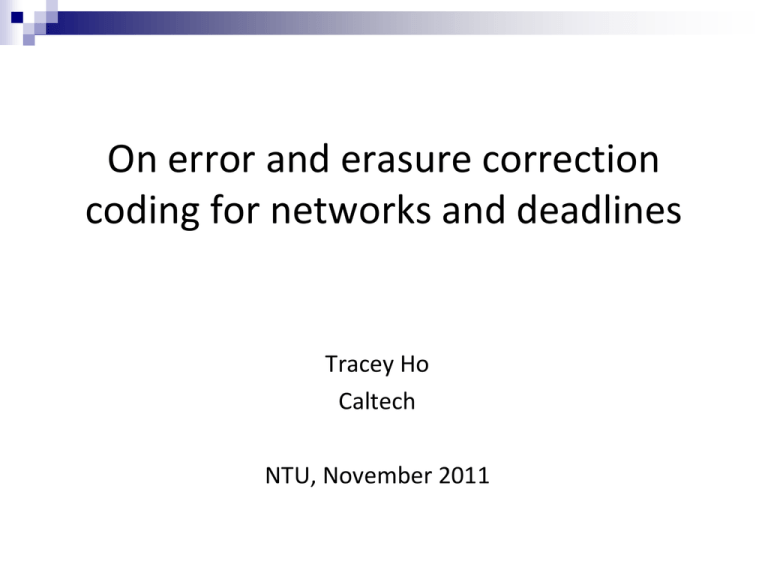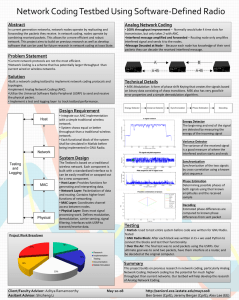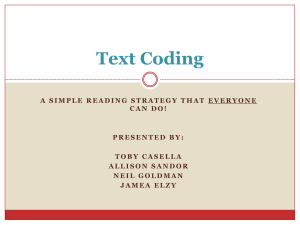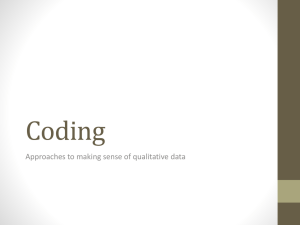Slides
advertisement

On error and erasure correction
coding for networks and deadlines
Tracey Ho
Caltech
NTU, November 2011
Network error correction problem
s2
t1
s1
t2
z unknown
erroneous links
network
• Problem of reliable communication under arbitrary errors on z
•
•
links (or packets)
The set of erroneous links is fixed but unknown to the network
user → cannot do error correction on individual links separately
Erasure correction is a related problem
2
Background – network error correction
•
The network error correction problem was introduced
by [Cai & Yeung 03]
• Extensively studied in the single-source multicast case
with uniform errors
− Equal capacity network links (or packets), any z of
which may be erroneous
− Various capacity-achieving code constructions, e.g.
[Cai & Yeung 03, Jaggi et al. 07, Zhang 08, Koetter &
Kschischang 08]
This talk : theory and applications of
network error correction
1. Multi-source multicast network error correction
− Application to key pool bootstrapping
2. Network error/erasure correction as a model for analyzing
reliable communication with deadlines
3. Combining information theoretic and cryptographic
security against adversarial errors for computationally
limited nodes
x
x
m1
I1
m2
I2
m3
I3
t1
I1
t2
I1 , I2
t3
I1 , I2 , I3
This talk : theory and applications of
network error correction
1. Multi-source multicast network error correction
− Application to key pool bootstrapping
2. Network error/erasure correction as a model for analyzing
reliable communication with deadlines
3. Combining information theoretic and cryptographic
security against adversarial errors for computationally
limited nodes
4. Non-uniform network error correction
Outline
• Multiple-source multicast, uniform errors
• Coding for deadlines: non-multicast nested networks
• Combining information theoretic and cryptographic security:
single-source multicast
• Non-uniform errors: unequal link capacities
Outline
• Multiple-source multicast, uniform errors
T. Dikaliotis, T. Ho, S. Jaggi, S. Vyetrenko, H. Yao, M. Effros, J. Kliewer and E.
Erez, IT Transactions 2011.
• Coding for deadlines: non-multicast nested networks
• Combining information theoretic and cryptographic security:
single-source multicast
• Non-uniform errors: unequal link capacities
Background – single-source multicast,
uniform z errors
• Capacity = min cut – 2z, achievable with linear network
codes (Cai & Yeung 03)
• Capacity-achieving codes with polynomial-time decoding:
− Probabilistic construction (Jaggi, Langberg, Katti, Ho,
Katabi & Medard 07)
− Lifted Gabidulin codes (Koetter & Kschischang 08, Silva,
Kschischang & Koetter 08)
8
Multiple-source multicast,
uniform z errors
Source 1
• Sources with independent information
• We could partition network capacity among
different sources…
• But could rate be improved by coding across
different sources in the network? To what extent
can different sources share network capacity?
• Challenge: owing to the need for coding across
sources in the network and independent
encoding at sources, straightforward extensions
of single-source codes are suboptimal
• Related work: code construction in (Siavoshani,
Fragouli & Diggavi 08) achieves capacity for
C1+C2=C
Source 2
Sink
Multiple-source multicast,
uniform z errors
Source 1
• Sources with independent information
• We could partition network capacity among
different sources…
• But could rate be improved by coding across
different sources in the network? To what extent
can different sources share network capacity?
• Challenge: owing to the need for coding across
sources in the network and independent
encoding at sources, straightforward extensions
of single-source codes are suboptimal
• Related work: code construction in (Siavoshani,
Fragouli & Diggavi 08) achieves capacity for
C1+C2=C
Source 2
Sink
Multiple-source multicast,
uniform z errors
Source 1
• Sources with independent information
• We could partition network capacity among
different sources…
• But could rate be improved by coding across
different sources in the network? To what extent
can different sources share network capacity?
• Challenge: owing to the need for coding across
sources in the network and independent
encoding at sources, straightforward extensions
of single-source codes are suboptimal
• Related work: code construction in (Siavoshani,
Fragouli & Diggavi 08) achieves capacity for
C1+C2=C
Source 2
Sink
Multiple-source multicast,
uniform z errors
Source 1
• Sources with independent information
• We could partition network capacity among
different sources…
• But could rate be improved by coding across
different sources in the network? To what extent
can different sources share network capacity?
• Challenge: owing to the need for coding across
sources in the network and independent
encoding at sources, straightforward extensions
of single-source codes are suboptimal
• Related work: code construction in (Siavoshani,
Fragouli & Diggavi 08) achieves capacity for
C1+C2=C
Source 2
Sink
Multiple-source multicast,
uniform z errors
Source 1
• Sources with independent information
• We could partition network capacity among
different sources…
• But could rate be improved by coding across
different sources in the network? To what extent
can different sources share network capacity?
• Challenge: owing to the need for coding across
sources in the network and independent
encoding at sources, straightforward extensions
of single-source codes are suboptimal
• Related work: code construction in (Siavoshani,
Fragouli & Diggavi 08) achieves capacity for
C1+C2=C
Source 2
Sink
Capacity region
• U = set of source nodes
• mS = min cut capacity between sources in subset S of U
and each sink
• ri = rate from the ith source
• Theorem: The capacity region (coherent & non-coherent)
under any z link errors is given by the cut set bounds
r m
iS
i
S
2 z, S U
Source 1
• Example: z = 1
r1 ≤ m1 -2z =1
r2 ≤ m2 -2z = 1
(r1 + r2 ≤ m -2z = 2)
Source 2
Sink
Capacity region
• U = set of source nodes
• mS = min cut capacity between sources in subset S of U
and each sink
• ri = rate from the ith source
• Theorem: The capacity region (coherent & non-coherent)
under any z link errors is given by the cut set bounds
r m
iS
i
S
2 z, S U
Source 1
• Example: z = 1
r1 ≤ m1 -2z =1
r2 ≤ m2 -2z = 1
(r1 + r2 ≤ m -2z = 2)
Source 2
Redundant capacity is
completely shared!
Sink
Achievable constructions
1. Probabilistic construction, joint decoding of multiple
sources
− Requires a different distance metric for decoding than
single source multicast decoding metric from Koetter
& Kschischang 08
2. Gabidulin codes in nested finite fields, successive
decoding
Background - Gabidulin codes
n1
M=
M = Fqq
n
r
r
Background - Gabidulin codes
n 1
M =FqFq
GM =
GM
Channel
1
n
r
= Fq
n
r+t
GM +E
• Transmit [I x], where x is a codeword of a Gabidulin code
• Achieves capacity C – 2z for single-source multicast with efficient
decoding algorithms (Koetter & Kschischang 08, Silva,
Kschischang & Koetter 08)
Nested Gabidulin codes for multiple
source multicast
• Interior nodes do random linear network coding in GF(q)
• Sources encode with Gabidulin codes over nested
extension fields GF(q n1 ), GF(qn1n2 ),…, GF(q n1n2…nk. )
where ni ≥ ri +2z
• Enables successive decoding at the sinks, starting from
outermost source k
Nested Gabidulin codes - 2 sources
Y=T1G1M1+T2G2M2+E
(1)
M1
T2
E (2)
G 2 M 2
G11
Y T1G
G11 T2 Fqmn m invertible whp for RLNC
D T1G
D
1
(D-1Y)
M1
1
-1
D
D EE lowest r +2z
=
2
G22 M 2
rows
1
(D-1Y) G
G22 M 2 (D
( D-1E)
E )
n1
Matrix of rank z over Fq
(3)
Matrix of rank z over Fq
An application: key pool
bootstrapping
• A key center generates a set of keys {K1, K2, … }, a subset of
which needs to be communicated to each network node
• Instead of every node communicating directly with the key
center, nodes can obtain keys from neighbors who have the
appropriate keys
• Use coding to correct errors from corrupted nodes
Key pool bootstrapping
• Problem is equivalent to multi-source network error correction
V1
V2
V3
V4
V5
k1, k2
k1, k2
k1, k2
k1, k3
k1, k3
V6
V7
V8
V9
k1, k3
k2, k3
k2, k3
k2, k3
V8
V9
R
S1
V1
V2
V3
S2
V4
V5
S3
V6
V7
R
• Coding across keys is needed for optimal error resilience
Outline
• Multiple-source multicast, uniform errors
• Coding for deadlines: non-multicast nested networks
O. Tekin, S. Vyetrenko, T. Ho and H. Yao, Allerton 2011.
• Combining information theoretic and cryptographic security:
single-source multicast
• Non-uniform errors: unequal link capacities
Background - non-multicast
• Finding the capacity region of a general non-multicast
network even in the erasure-free case is an open problem
− Coding across different sinks’ packets (inter-session
coding) is sometimes required
− We don’t know in general when intra-session coding is
sufficient
• We can derive cut set bounds by analyzing three-layer
networks (Vyetrenko, Ho & Dikaliotis 10)
Motivation
x
x Packet erasures/errors
Initial play-out delay m1
I1
m2
I2
m3 Decoding deadlines
I3 Demanded information
Three-layer nested networks
t1
I1
t2
I1 , I2
t3
I1 , I2 , I3
• A model for temporal demands
• Links ↔ Packets
• Sinks ↔ Deadlines by which
certain information must be
decoded
• Each sink receives a subset of the
information received by the next
(nested structure)
• Packet erasures can occur
• Non-multicast problem
Erasure models
We consider two erasure models:
• z erasures (uniform model)
− At most z links can be erased, locations are unknown
a priori.
• Sliding window erasure model
z erasures – upper bounding
capacity
t1
I1
t2
I1 , I2
t3
I1 , I2 , I3
• Want to find the capacity region of
achievable rates u1,u2,…,un
• We can write a cut-set bound for
each sink and erasure pattern (choice
of z erased links)
u1 ≤ m1 ̶ z
u1+u2 ≤ m2 ̶ z
…
u1+u2+…+un ≤ mn ̶ z
• Can we combine bounds for multiple
erasure patterns and sinks to obtain
tighter bounds?
Cut-set combining procedure
Example: m1=3,m2=5, m3=7, m4=11, z=1
u1+H(X1X2|I1) ≤2
u1+H(X1X3|I1) ≤2
u1+H(X2X3|I1) ≤2
12
1245
124567
13
1345
134567
23
2345
234567
1234
1235
123467
123567
1234567
123456
123457
1234567
123456
123457
1234567
•Iteratively apply steps:
1234567
1234567
Extend: H(X |I1i-1)+ |Y| ≥ H(X,Y |I1i-1)= H(X,Y |I1i)+ ui
where X,Y is a decoding set for Ii
| X | 1
Combine:
H ( Z , A | I )
A: A X ,| A| k
k
i
1
H (Z , X | I1i )
Upper bound derivation graph
Example: m1=3,m2=5, m3=7, m4=11, z=1
Capacity region:
12
1245
u1≤2
13
1345
3u1+2u2 ≤8
23
2345
3u1+2u2+u3 ≤9
1234
6u1+5u2+4u3 ≤24
1235
6u1+4u2+2u3+u4≤20
9u1+6u2+4u3+3u4 ≤36
6u1+5u2+4u3+2u4 ≤28
6u1+4.5u2+4u3+3u4 ≤30
9u1+7.5u2+7u3+6u4 ≤54
•
•
•
•
124567
134567
234567
1234567
123467
123567
1234567
123456
123457
1234567
123456
123457
1234567
1234567
Different choices of links at each step give different upper bounds
Exponentially large number of bounds
Only some are tight – how to find them?
We use an achievable scheme as a guide and show a matching
upper bound
Intra-session Coding
•
•
•
•
yj,k : capacity on kth link allocated to jth message
We may assume yj,k = 0 for k>mj
P : set of unerased links with at most z erasures
A rate vector (u1,u2,…,un) is achieved if and only if:
1
2
…
mn
ΣP
I1
y1,1
y1,2
…
y1,m_n
≥ u1
I2
y2,1
y2,2
…
y2,m_n
≥ u2
…
…
…
…
…
In
yn,1
yn,1
…
yn,m_n
Σ
≤1
≤1
≤1
≥ un
“As uniform as possible” intra-session
coding scheme
• Fill up each row as uniformly as possible subject to constraints
from previous rows
• Example:
m1 = 10, m2 = 14, m3 = 18, m4 = 22,
u1 = 6, u2 = 3, u3 = 3, u4 = 4, z=2
1,2,…,9,10
11,12,13,14
u4 uu
u412*34 0.25 6
33
4 433
u4
3
000
.75
.25
.1875
2
0
0...4
5
0
5
m
m4m
m
z
z
14
22
22
22
2
10
2
14
18
2
4m
1
2m
4
1z
2
3
m
m
zzz 10
18
10
2
22
3
1
15,16,17,18
I1
0.75
I2
0.25
0.25
I3
0
0.1875
0.5
0.1875
0.5
0.1875
I4
0.2
0
0.25
0.4
0.2
0.4
0.2
0.5
19,20,21,22
0.4
0.2
0.5
Can we do better?
Capacity region
Theorem: The z-erasure (or error) correction capacity region
of a 3-layer nested network is achieved by the “as
uniform as possible” coding scheme.
Proof Idea
• Consider any given rate vector (u1,u2,…,un) and its
corresponding “as uniform as possible” allocation:
1,2,…,m1 m1 +1,…,m2
m2 +1,…,m3
…
I1
T1,1
I2
T2,1
T2,2
I3
T3,1
T3,2
T3,3
…
…
…
…
…
In
Tn,1
Tn,2
Tn,3
…
mn-1 +1,…,mn
Tn,n
• Obtain matching information theoretic bounds, by using Ti,j
values to choose path through upper bound derivation graph
Proof Idea
mk
m2
mn
m1
W1
W2
…
Wk
• Consider any unerased set W W1 W2 ...Wk with at most z
erasures.
• Show by induction: The conditional entropy of W given
messages I1,…, Ik matches the residual capacity in the table,
k
k
i.e.
H (W | I ,...,I ) | W | (1 T )
1
k
i 1
i
j 1
j ,i
Proof Idea
• For any set V W with |V|= mk-z, an upper bound for
H(V| I1k) can be derived as follows:
− let V’ be the subset of V consisting of links upstream of tk-1
− obtain H(V’| I1k-1) from the table (induction hypothesis)
− extend : H(V |I1k) ≤ H(V’|I1k-1)+ |V \V’| − uk
• For each row k, there exists a column k* such that all Ti,j are
all equal for j>k*
• Combine over all such V W having erasures on links
mk*+1,mk*+2,…, mk to obtain:
k
k
i 1
j 1
H (W | I1 ,...,I k ) | Wi | (1 T j ,i )
z-error capacity region
• A linear non-multicast code that can correct 2z erasures
can correct z errors [Vyetrenko, Ho, Effros, Kliewer &
Erez 09]
• An arbitrary code for a three-layer network that can
correct z errors can correct 2z erasures (Singleton-type
argument)
• Since our capacity-achieving code is linear, the z-error
capacity region is the same as the 2z-erasure capacity
region
Sliding window erasure model
• Parameterized by erasure rate p and burst parameter T.
• For y≥T, at most py out of y consecutive packets can be
erased.
• Erasures occur with rate p in long term.
• Erasure bursts cannot be too long (controlled by T ).
Sliding window erasure
achievable region
• Theorem: Let the rate vector u be achievable. Then the
rate vector
1
1 p
u
m1 T 1 p 1
1 log
T
m
1
is achieved by “as uniform as possible” coding.
• Note: asymptotically optimal for m1 >> T >>1
Outline
• Multiple-source multicast, uniform errors
• Coding for deadlines: non-multicast nested networks
• Combining information theoretic and cryptographic security:
single-source multicast
S. Vyetrenko, A. Khosla & T. Ho, Asilomar 2009.
• Non-uniform errors: unequal link capacities
Problem statement
• Single source, multicast network
• Packets may be corrupted by adversarial errors
• Computationally limited network nodes (e.g. low-power
wireless/sensor networks)
Background: information-theoretic
and cryptographic approaches
• Information theoretic network error correction
− Existing codes are designed for a given upper bound
zU on the number of errors, achieve rate mincut -2zU,
e.g. [Yeung and Cai 03]
• Cryptographic signatures with erasure correction
− Cryptographic signatures allow network coded
packets to be validated, e.g. [Zhao et al. 07, Boneh et
al. 09]
− If all packets are signed and each network node
checks all packets, then rate mincut - z can be
achieved, where z is the actual number of erroneous
packets
Motivation for hybrid schemes
• Performing signature checks at network nodes requires
significant computation
• Checking all packets at all nodes can limit throughput
when network nodes are computationally weak
• Want to use both path diversity as well as cryptographic
computation as resources, to achieve rates higher than
with each separately
Approach
• Cannot afford to check all packets
use probabilistic
signature checking
• Deterministic bound on number of erroneous packets is
needed in existing network error correction code
constructions
• Rather than have to choose a conservative bound, we
want a code construction that does not require an upper
bound on the number of errors to be known in advance
Fountain-like network error
correction code
• We propose a fountain-like error-correcting code which
incrementally sends redundancy until decoding succeeds (verified
by signature checks)
• Each adversarial error packet can correspond to an addition (of
erroneous information) and/or an erasure (of good information)
• Construction:
Message
IB
For additions
Linearly independent redundancy
0
I
For erasures
Linearly independent redundancy
0
0
B
Linearly dependent redundancy
Linearly dependent redundancy
I
Example: simple hybrid strategy on
wireless butterfly network
source
D
sink1
sink 2
Node D has limited computation
and outgoing capacity
→ Carries out probabilistic
signature checking/coding
− Proportion of packets
checked/coded chosen to
maximize expected information
rate subject to computational
budget
Example: simple hybrid strategy on
wireless butterfly network
cost of checking
40, mincut 200, z 20
cost of coding
Outline
• Multiple-source multicast, uniform errors
• Coding for deadlines: non-multicast nested networks
• Combining information theoretic and cryptographic security:
single-source multicast
• Non-uniform errors: unequal link capacities
S. Kim, T. Ho, M. Effros and S. Avestimehr, IT Transactions 2011.
T. Ho, S. Kim, Y. Yang, M. Effros and A. S. Avestimehr, ITA 2011.
Uniform and non-uniform errors
• Uniform errors:
− Multicast error correction capacity = min cut – 2z
− Worst-case errors occur on the min cut
• Non-uniform errors:
− Model: network with unequal link capacities, adversarial
errors on any z fixed but unknown links
− Not obvious what are worst-case errors
• Cut size versus link capacities
• Feedback across cuts matters
− Related work: Adversarial nodes (Kosut, Tong & Tse 09)
Network cuts
S
U
• Only forward link
capacities matter in the
equal link capacity case
• Both forward and feedback
links matter in the unequal
link capacity case
• Feedback can
provide
information about
errors on upstream
links
50
Two-node cut set bounding
approach
S
U
Two-node network with n
forward links and m feedback
links
51
Tighter cut set bounding approach
• The two-node cut set bounding approach is equivalent to
adding reliable, infinite-capacity bidirectional links between
each pair of nodes on each side of the cut
• Tighter bounds can be obtained by taking into account which
forward links affect or are affected by which feedback links
• Equivalent to adding a link (i,j) only if there is a directed path
from node i to node j on that does not cross the cut
Zigzag network
52
Downstream condition
• A set of links K on a cut Q is said to satisfy the
downstream condition if none of the remaining links
on the cut Q are downstream of any link in K.
K
K
53
Generalized Singleton bound
Generalized Singleton bound [Kim, Ho,
Effros & Avestimehr 09, Kosut, Tong &
Tse 09]:
For any cut Q, after erasing any 2z links
satisfying the downstream condition,
the total capacity of the remaining
links in Q is an upper bound on error
correction capacity.
When z=3, generalized
Singleton bound is
3+3+3+3=12
54
Generalized Singleton bound - intuition
• Suppose the bound is violated. Then
there exist two codewords x, x’ that
differ in 2z links satisfying the
downstream condition and agree on the
remaining links
• There exist error values e, e’ such that
sink U cannot distinguish (x,e) and (x’,e’)
a
a
b
55
c'
d'
b'
c'
d
b'
a
b'
c
a
c'
d''
d"
Idea 1
• Observation: generalized
Singleton bound is not tight
when downstream links have
smaller capacities.
Idea 1: erase any k≤z largest
capacity links and apply
Singleton bound with z-k
adversarial links on remaining
network.
56
Idea 2
If adversary controls some forward links as well as their
downstream feedback links, he can hide his errors
y1
y2
u1 ’
y1
y2
u2’
u2’
y1,y2,u1’,u2’
w1
w3
u1’
y1,y2, u1’, u2’
w1’
y3
y6
w3’ y3
yy66
Idea 3
Observation: For small feedback link capacities, distinct
codewords have the same feedback link values
Idea 3: adversary can cause confusion between
codewords that agree on the feedback links
y1’
y2’
y1’
y3
1
u
y2’
y3
1
u
y4
y5
y6
y4
y7
y5
y6'
y 7'
New cut-set bound
For any cut Q,
• adversary first erases a set of k ≤ z forward links (idea 1)
• adversary then chooses two sets Z1 ,Z2 of z-k links such that
any feedback link directly downstream of links in both Z1 and
Z2 and upstream of a forward link in Q\Z1\Z2 is included in
both Z1 and Z2 (idea 2)
• let Wi be the set of feedback links not in Zi (idea 2) that are
directly downstream of a link in Zi and upstream of a forward
link in Q\Z1\Z2 (idea 3)
• sum of capacities of remaining forward links + capacities of
links in W1 ,W2 is an upper bound
Bound is tight on some families of zig-zag networks
Achievability - example
• For z=1, upper bound = 5
• Without feedback link, capacity = 2
• Can we use feedback link to achieve
rate 5?
z=1
Achieve rate 3
using new code
construction
“Detect and forward”
coding strategy
a +f
b a
b
y1
∞
y2
∞
f
y3
y4
z=1
capacity= 5
• Some network capacity is allocated to
redundancy enabling partial error
detection at intermediate nodes
• Nodes that detect errors forward
additional information allowing the sink to
locate errors
• Use feedback capacity to
z=1increase the
number of symbols transmitted with error
Achieve rate 3
detection
using new code
• Remaining network
capacity carries
construction
generic linear combinations of information
symbols, serving as an MDS error
correction code
Conclusion
• Network error correction as a model for analyzing and
designing codes for robust streaming
• Coding for adversaries: Information theoretic and hybrid
cryptographic approaches
• New codes and outer bounds for more general networks
and communication demands
• Thank you!
Coherent & non-coherent models
• Coherent: network topology known, centralized code
design
• Non-coherent (multicast): network topology unknown,
use distributed random linear network coding (RLNC)
• each packet comprises a vector of symbols from
a finite field Fq
• each node sends linear combinations of its
received packets with coefficients chosen
(a1,…, an)
uniformly at random from Fq
(b1,…, bn)
• record network transformation in packet
headers, or encode information in subspaces
(γa1 +λb1,…,γan+λbn)
Coding and decoding
• Coding over blocks (generations) of B source packets
• Phase i 0: transmit B source packets
• Phase i 0 : transmit i m / 2 linearly independent redundant packets and
i m / 2 linearly dependent redundant packets
• At each phase the sink tries to decode (using a polynomial-time decoding
algorithm similar to [Jaggi et al., 2007]), and performs signature checks on the
decoded packets
• If the decoded packets pass the signature checks, the sink sends feedback
telling the source to move on to the next block
IB
B
1
1
2
2
Linearly independent redundancy
0
Im/ 2
Linearly dependent redundancy
Linearly independent redundancy
Linearly dependent redundancy
0
0 Im/ 2
Field Extensions: example
1 0 0 0
2 0
8
24
22
21
1 1 0 1 F2 3 1 F4 13 F16
Field Extensions
Fq n n
Fq n
1 2
1
Fq
G1
G2
G1 can correct
xrank z
Merrors
=
1
over Fq
n
G2 can correct
xrank z
Merrors
=
2
over Fq n1
n = kn1n2 where ni≥ri +2z
X1
n
X2
r2+2z
r2+2z
r2
n
n
r1+2z
r1+2z
r1
Encoding
Decoding
Matrix of rank z over Fq
(D-1Y)= G2M2+(D-1E)
Matrix of rank z over Fq n1
(This is why we need the extension field)
• M2 can be decoded (same as single-source decoding
problem)
• Decoder then subtracts effect of M2 and decodes M1
Idea 1 - example
Four-node network with z=2 .
Singleton bound is 3 x 5 +1 =
16.
a) First erase one link with
largest capacity.
b) Apply Singleton bound
on remaining network for
z=1.
New bound is
3+3+3+3+1+1+1=15 <16
70







